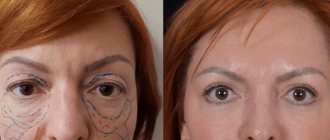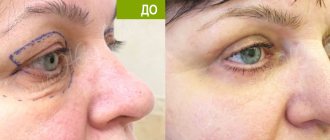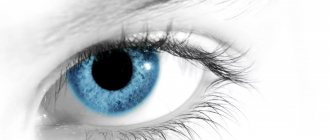Circular blepharoplasty is a simultaneous plastic surgery of the lower and upper eyelids. In fact, this is the most effective way to get rid of wrinkles in the eye area and restore a youthful, attractive appearance to your eyes. Unlike procedures aimed at rejuvenation, such as bioreinforcement of the face with injections of Botox or hyaluronic acid, the result of a circular eyelid lift lasts up to 10 years.
This procedure allows you to eliminate such age-related deficiencies as:
- Drooping upper eyelid
- Hernias in front of the eyes
- Wrinkles around the eyes
- Drooping corners of the eyes
- Remove hernias in the area under the eyes
- Asymmetry and much more
Circumferential eyelid surgery is performed on people over the age of 35 who have excess skin in the lower and upper eyelids. If the skin is still young and only hernias in the eyes are a concern, then the patient is offered transconjunctival blepharoplasty.
Since this is a complex surgical operation, it has a number of contraindications, including:
- High eye pressure
- High blood pressure
- Blood clotting problems
- Diabetes
- Diseases of the heart and blood vessels
- Oncology
Before the operation you must:
Undergo a clinical and laboratory examination prescribed by your attending physician.
The day before and on the day of surgery, do not use any cosmetics (eye cream, face cream, lipstick, etc.), or perfume.
Avoid alcohol three days before surgery.
2 weeks before surgery, exclude lemon and all aspirin-containing drugs, as well as any anticoagulants from food.
On the eve of the operation, you should wash your hair and face. Wash thoroughly immediately before surgery.
Three days before surgery, take Dicinon - 2 tablets 3 times a day, as well as another tablet in the morning on the day of surgery.
On the day of the operation, come to the clinic at the appointed time.
Eye to eye: blepharoplasty pros and cons
An open look is one of the main markers of a youthful face.
But if your eyes no longer look at the world the same way they used to, it may be worth making an appointment with a plastic surgeon. Tissue aging occurs individually in each person. As a rule, age-related changes occur in the periorbital area (the area around the eyes) several years earlier than the face as a whole. It is not surprising that blepharoplasty is often treated as a separate operation, rather than performed in combination with a facelift (facelift).
One of the fundamental indications for surgical treatment of age-related facial changes is the patient’s desire. The surgeon’s task is to evaluate these changes taking into account existing constitutional and anatomical factors and make a decision on the advisability of surgical correction.
In recent years, the strategy for eyelid surgery has not changed fundamentally. However, surgeons are increasingly resorting to variations of this operation to reduce trauma to the orbicularis oculi muscle. For example, the so-called fatty hernias under the eyes are not removed, but are redistributed along the nasolacrimal groove, due to which the relief of this area is leveled. Transconjunctival blepharoplasty is also more widely used, solving the problem of swelling of the lower eyelids in young women. By the way, this detail of appearance is sometimes not a consequence of aging at all, but a constitutional feature of a person.
In the absence of indications for surgery, laser resurfacing, mesotherapy and contouring can be used. Of course, the listed techniques should not be considered as an alternative to surgical methods. It is correct to talk about a combination of different solutions to achieve the most pronounced anti-aging effect.
Upper blepharoplasty
This type of surgery is performed under either general or local anesthesia or sedation. Excess skin hanging over the eyes is excised, and fatty hernias are removed. The incision is made in the natural crease of the upper eyelid, which makes the seam almost invisible. In addition to the classical method (using a scalpel), laser blepharoplasty is also used, in which the incision is made with a laser beam.
Lower blepharoplasty
It is performed to remove or distribute fatty hernias and excess skin. The incision is made along the eyelash line on the lower eyelid. If it is only necessary to remove fatty hernias, then transconjunctival blepharoplasty (with access through an incision on the inside of the lower eyelid) is often performed. There are no noticeable marks left after such an operation. It is often necessary to prepare the skin for eyelid surgery. Because if it is not elastic enough, then the operation becomes more difficult, and in addition, such skin heals more slowly. For preparation, injection and hardware procedures are used to improve the quality of the skin.
Aesthetic correction of eye shape
Among the types of blepharoplasty, there are also corrections that allow you to change the shape of the eyes, make it more almond-shaped or, conversely, European, raise drooping outer corners, correct asymmetries, eliminate eversion of the eyelids or protrusion of the eyeball. Canthopexy, canthoplasty and epicanthoplasty are indicated for these purposes. These operations are performed in the inner and outer corners of the eyes, working with the canthal ligaments that hold the eyelid. They are tightened and secured in the desired position, and if necessary, shortened. Such interventions require certain skills and precision precision.
Rehabilitation
In most cases, the patient is allowed to go home three to five hours after surgery.
If the operation was performed under general anesthesia, you can leave the clinic only the next day. Recovery from blepharoplasty usually takes two to three weeks. All this time you need to remain calm and absolutely not strain your eyes: do not touch, do not rub them, do without active facial expressions, do not read, do not watch TV, go outside only wearing sunglasses. Also, in the first days after surgery, special eye drops and cold compresses are usually prescribed. It will be possible to evaluate the result of eyelid surgery only after you have finally gotten into shape: all swelling has subsided, redness and bruising have disappeared. Sometimes, to improve the effect and speed up rehabilitation, hardware procedures (for example, microcurrent therapy) are used. The result of the operation lasts up to 10 years.
During rehabilitation, keep yourself occupied, for example, by listening to audiobooks, so you won’t feel cut off from civilization.
Important
Contraindications to blepharoplasty include infectious eye diseases, eye pressure, decompensated glaucoma, dry eye syndrome, therefore, consultation with an ophthalmologist is a mandatory point of examination before surgery.
Problems and solutions
Problem:
pronounced excess skin of the upper eyelid, drooping eyelids, significant fatty hernias.
Solution:
surgical correction.
Problem:
change in the quality of the skin around the eyes: decreased turgor, change in color.
Solution:
hardware correction (RF lifting, ultrasound lifting, laser rejuvenation).
Problem:
insufficient volumes, retraction of the nasolacrimal groove.
Solution:
contour plastic surgery (injection procedures).
You should not insist on plastic surgery if there are no clear indications. Any surgical intervention carries certain risks. Therefore, with minor age-related changes and some aesthetic wishes (following fashion), it is better to turn to alternative correction methods.
Lift my eyelids: what is personalized blepharoplasty
Read more
Eyes like Bella Hadid: canthoplasty (will create an open look or a sly squint)
Read completely
Young look: what is blepharoplasty (indications for surgery and alternative methods)
Read completely
Immediately after surgery:
You may feel a slight painful sensation, reminiscent of a burning sensation in the eyelids under the rays of the scorching sun. During this period (when the effect of the anesthetic wears off), you lie on your back for 2 hours with ice packs on your eyelids, which eliminates pain and prevents the development of bruises. If necessary, pain medications may be administered, which is usually not required, but can be done at the request of the patient.
After the operation, the surgeon will examine you and give you the necessary recommendations.
Do not remove the gauze bandages placed on your eyelids after surgery yourself.
Rehabilitation period by day
1 day. The patient is discharged from the clinic after the operation. On this day, the eyes are most sensitive to light, so it is recommended to have dark glasses with you to put on before going outside. By evening, swelling increases. Possible lacrimation, dry eyes, blurred vision.
To reduce pain, your doctor may prescribe analgesics. Any medications (drops, ointments) should be used only as prescribed by a doctor. It is necessary to remain calm and avoid any strain on the eyes. You need to sleep on your back, with your head elevated, to improve the flow of fluid from the upper body and reduce swelling.
2-3 days. Painful sensations decrease, swelling, on the contrary, increases, reaching a maximum on the 3rd day. It is acceptable to use a cold compress on the eyes - apply an ice pack wrapped in several layers of clean, dry cloth to the operated area. There may be numbness and impaired sensitivity of the skin in the surgical area.
These days you can already wash your face and hair, trying not to wet the skin of your eyelids. As before, you should try not to strain your eyesight, devote a minimum of time to reading, watching TV, and working at the computer. The patient must continue to follow all the doctor’s prescriptions - drops, treatment of sutures if necessary.
3-5 days. Symptoms persist or improve slightly.
5-7 day . Usually on the 5th day a follow-up examination is scheduled in the clinic, the surgeon removes the sutures (if self-absorbable threads were not used). There may be redness and slight swelling in the area of the sutures.
7-10 days. Symptoms gradually decrease, and by day 10 the patient can return to normal life with some restrictions on eye strain. After 10-14 days you can wear contact lenses.
The final result of the operation can be assessed after 1-2 months. By this time, the epidermis of the skin of the eyelids is renewed, the seams become unnoticeable. After six months, postoperative scars are almost impossible to detect; they look like a thin strip in the crease of the upper eyelid or along the lower edge of the eyelashes.
Restrictions after surgery
For 2 weeks, it is highly advisable to sleep on your back, it is permissible to sleep on your side, but it is strictly forbidden to sleep on your stomach.
The next day after surgery, you need to come to the clinic for examination, removal of gauze bandages and treatment of sutures, then on the 3rd day after surgery for removal of sutures and examination, and also 2 weeks after surgery to assess the healing process.
For 2 weeks, follow all the surgeon’s recommendations.
Under no circumstances should you remove small crusts on the seams yourself! You may feel a slight itch in the area of the stitches; this indicates a normal healing process.
On the 4th day after surgery (the day after the stitches are removed): you can begin to carefully wash your face with water and wet the stitches. After each contact with water, treat the sutures with a preparation recommended by the surgeon. You can use the face cream, moving 5 cm away from the suture line on the lower eyelids. Avoid direct application of the cream on the upper eyelids. Use only those cosmetics to which you have definitely not had allergic reactions before (for this reason, you should not use new ones that you have not used before).
For 2 weeks, do not take a bath (shower only), avoid swimming in the pool, do not drink alcohol, do not exercise, do not lower your head below your waist, do not do anything that causes an increase in blood pressure.
Do not sunbathe for up to a month.
Avoid colds.
Decorative cosmetics can be used 2 weeks after surgery, after a follow-up examination with a surgeon.
The rehabilitation process may vary depending on the individual characteristics of the patient and the operation performed, and can take from 3 weeks to 5 months, so do not worry and remain calm and confident, go for routine examinations.
You should consult your doctor immediately if you experience any new, unusual symptoms or signs of deterioration at any time after surgery (sudden sharp pain, severe bruising accompanied by severe swelling of the eyelids with the inability to open the eye). Such signs are extremely rare, but can signal a problem that requires immediate intervention.
How is blepharoplasty of the lower and upper eyelids performed?
The operation is quite extensive, so it is performed under general anesthesia and lasts from 1.5 to 3 hours.
At the first stage, markings are made on the lower and upper eyelids (the operated area is first disinfected).
Correction of the lower eyelids may include classic lower eyelid surgery with an incision along the edge of the eyelash growth, or may include transconjunctival lower blepharoplasty.
After the administration of anesthesia, an incision is made on the upper eyelid. Then excess fatty tissue and skin are removed. After applying the suture, the plastic surgeon begins correction of the lower eyelid, which is carried out according to the same scheme.
Having operated on one eye, the doctor begins to work on the second.
Photos before and after blepharoplasty
See also:- Blepharoplasty: everything about the operation
- Blepharochalasis: everything about the disease
Blepharoplasty up to 40 years
Some unpleasant manifestations occur at the age of 35-40 years. At this time, the epidermis and facial muscles begin to gradually lose their natural tone. And if high-quality anti-aging care cosmetics and procedures from hardware cosmetology are initially effective, later you will still have to choose: not to interfere with natural processes, or to correct deficiencies with the help of plastic surgery.
The reasons for surgery at this age may be:
- congenital weakness of the orbicularis oculi muscle - the accumulating lipid tissue protrudes significantly, forming bags, giving the face fatigue, an unhealthy appearance, and extra age;
- lymphoid eyelid - excess epidermis above the eyes, making a person visually much older than his age;
- the need to change the shape of the eyes, which is especially important for people with an Asian type of appearance.
In any case, the operation is always preceded by a face-to-face consultation with a specialist. Even obvious aesthetic flaws are not always a reason to take radical measures. Having considered a specific situation, the plastic surgeon often does not comply with the patient’s desire to make a correction at an early age. The doctor can offer non-invasive correction methods, such as ultrasonic lifting, microcurrent therapy, laser resurfacing. And only when other methods of correction can the need for surgical intervention be justified.
Blepharoplasty after 50 years
At this age, the realization that youth is passing no longer scares people, but the desire to look well-groomed remains. Of course, everything is individual, but the effect of isolated blepharoplasty in people over fifty will not be so noticeable, and it will not last long (about a year).
Therefore, plastic surgeons often recommend resorting to a circular facelift using a technique selected based on the patient’s characteristics. Six months after the facelift, when the final result of the procedure is visible, you can resort to blepharoplasty. In this combination, the effect of the procedure will be impressive and long-lasting.
What time of year is best to have blepharoplasty?
To protect yourself as much as possible from the side effects of surgical tightening of the area around the eyes and to shorten the rehabilitation period, it is better to plan the procedure in advance for autumn or winter. After blepharoplasty, direct sunlight on postoperative sutures is strictly prohibited for 3-4 months.
Any “immature” scar under the influence of ultraviolet radiation can become hyperpigmented. This process is irreversible, therefore, even after surgery performed during a season with short daylight hours, it is necessary to protect the operated area with sunglasses and use high-quality products with SPF.









